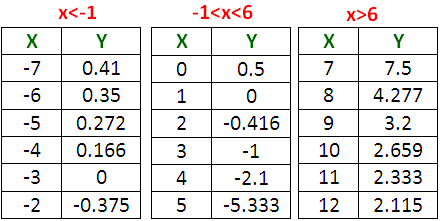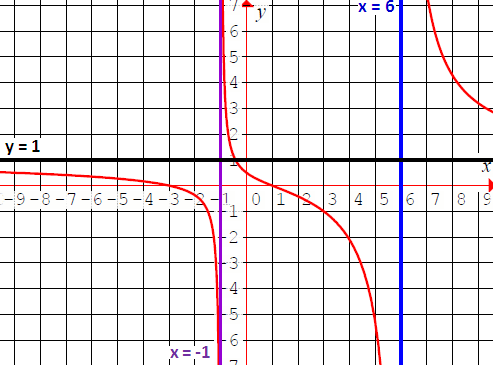DOMAIN AND RANGE OF RATIONAL FUNCTION GRAPHS
Subscribe to our ▶️ YouTube channel 🔴 for the latest videos, updates, and tips.
Domain of a Rational Function
Let y = f(x) be a function.
Domain is all real values of x for which y is defined.
If there is any value of x for which y is undefined, we have to exclude that particular value from the set of domain.
Example :
Let us consider the rational function given below.
In the above rational function, let us equate the denominator to zero.
x2 - 5x - 6 = 0
(x - 6)(x + 1) = 0
x - 6 = 0 or x + 1 = 0
x = 6 or x = -1
In the rational function given above, the denominator becomes zero when x = 6 and x = -1.
In the above rational function, if x = 6 and x = -1, then the denominator becomes zero and the value of 'y' becomes undefined.
So, 'y' is defined for all real values of 'x' except
x = 6 and x = -1
Therefore, the domain is
R - {-1, 6}
Range of a Rational Function
Let y = f(x) be a function.
Range is nothing but all real values of y for the given domain (real values of x).
Let us consider the rational function given below.
Range is nothing but the real values of 'y' for the given domain (real values of 'x').
To find range of the function, first we have to find inverse of f(x).
That is,
f-1(x)
But, for some rational functions, it is bit difficult to find inverse function.
For the rational function
it is bit difficult to find inverse function.
In that case, we have to sketch the graph of the rational function using vertical asymptote, horizontal asymptote and table of values as given below.
Vertical Asymptote :
To find vertical asymptote, we have to equate the denominator of the rational function to zero.
Let us equate the denominator of the rational function given below. to zero.
Then,
x2 - 5x - 6 = 0
(x - 6)(x + 1) = 0
x - 6 = 0 or x + 1 = 0
x = 6 or x = -1
So, the vertical asymptotes are x = -1 and x = 6.
Horizontal Asymptote :
In the rational function given below
the highest exponent of the numerator and denominator are equal and it is 2.
Equation of the horizontal asymptote :
y = a/b
Here 'a' and 'b' are the coefficients of highest exponent terms at the numerator and denominator respectively.
In our problem, a = 1 and b = 1.
So, horizontal asymptote is
y = 1/1
y = 1
Table of Values :
In the given rational function, now we have to plug some random values for 'x' and find the corresponding values of 'y'.
We have already known that the vertical asymptotes are
x = -1 and x = 6
Now, we have to take some random values for x in the following intervals.
x < -1
-1 < x < 6
x > 6
but not x = -1 and x = 6.
(Because, x = -1 and x = 6 are vertical asymptotes)

Graph of the Given Rational Function

When we look at the above graph, the following point is very clear.
That is, the graph (in red color) of the rational function
appears at every real value of 'y'.
(Even though horizontal asymptote is y = 1, the graph appears at y = 1. So y = 1 is also included in range)
So the range is all real values.
From the graph, clearly range is
R
Subscribe to our ▶️ YouTube channel 🔴 for the latest videos, updates, and tips.
Kindly mail your feedback to v4formath@gmail.com
We always appreciate your feedback.
©All rights reserved. onlinemath4all.com
Recent Articles
-
10 Hard SAT Math Questions (Part - 38)
Dec 08, 25 12:12 AM
10 Hard SAT Math Questions (Part - 38) -
SAT Math Practice
Dec 05, 25 04:04 AM
SAT Math Practice - Different Topics - Concept - Formulas - Example problems with step by step explanation -
10 Hard SAT Math Questions (Part - 37)
Dec 03, 25 07:02 AM
10 Hard SAT Math Questions (Part - 37)


